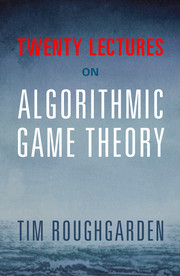Crossref Citations
This Book has been
cited by the following publications. This list is generated based on data provided by Crossref.
Monnot, Barnabé
Benita, Francisco
and
Piliouras, Georgios
2017.
Web and Internet Economics.
Vol. 10660,
Issue. ,
p.
340.
Chen, Carolyn
Krishnan, Sanjay
Laskey, Michael
Fox, Roy
and
Goldberg, Ken
2017.
An algorithm and user study for teaching bilateral manipulation via iterated best response demonstrations.
p.
151.
Jacquot, Paulin
Beaude, Olivier
Gaubert, Stephane
and
Oudjane, Nadia
2017.
Demand side management in the smart grid: An efficiency and fairness tradeoff.
p.
1.
Shakkottai, Srinivas
and
Srikant, R.
2017.
Handbook of Dynamic Game Theory.
p.
1.
Loke, Seng W.
2017.
Crowd-Powered Mobile Computing and Smart Things.
p.
27.
Rass, Stefan
2018.
Game Theory for Security and Risk Management.
p.
47.
Shakkottai, Srinivas
and
Srikant, R.
2018.
Handbook of Dynamic Game Theory.
p.
1143.
UMEDA, Hiroyuki
and
ASANO, Takao
2018.
Nash Equilibria in Combinatorial Auctions with Item Bidding and Subadditive Symmetric Valuations.
IEICE Transactions on Fundamentals of Electronics, Communications and Computer Sciences,
Vol. E101.A,
Issue. 9,
p.
1324.
Dakhil, Balsam
and
Gupta, Abhishek
2018.
Selling Renewable Generation with a Penalty for Shortfall.
p.
6495.
Merten, Samuel
Bagnall, Alexander
and
Stewart, Gordon
2018.
Programming Languages and Systems.
Vol. 10801,
Issue. ,
p.
561.
Vuelvas, Jose
Ruiz, Fredy
and
Gruosso, Giambattista
2018.
A contract for demand response based on probability of call.
p.
1095.
Yi, Changyan
and
Cai, Jun
2018.
Transmission Management of Delay-Sensitive Medical Packets in Beyond Wireless Body Area Networks: A Queueing Game Approach.
IEEE Transactions on Mobile Computing,
Vol. 17,
Issue. 9,
p.
2209.
Awaya, Yu
and
Krishna, Vijay
2019.
Communication and cooperation in repeated games.
Theoretical Economics,
Vol. 14,
Issue. 2,
p.
513.
Awaya, Yu
2019.
Collusion and Information Exchange.
The Japanese Economic Review,
Vol. 70,
Issue. 3,
p.
394.
Han, Seunghee
Soloviev, Matvey
and
Wang, Yuwen
2019.
Algorithmic Game Theory.
Vol. 11801,
Issue. ,
p.
185.
Marshall, Luke
Bruce, Anna
and
MacGill, Iain
2019.
Zero Operating Cost Renewables and Shadow Bidding in Wholesale Electricity Markets.
p.
1.
Heymann, Benjamin
2019.
Cost per action constrained auctions.
p.
1.
Roughgarden, Tim
and
Talgam-Cohen, Inbal
2019.
Approximately Optimal Mechanism Design.
Annual Review of Economics,
Vol. 11,
Issue. 1,
p.
355.
Yadav, Indu
Kulkarni, Ankur A.
and
Karandikar, Abhay
2019.
Strategy-Proof Spectrum Allocation among Multiple Operators.
p.
1.
Arbuzov, Vyacheslav
Awaya, Yu
and
Gudino, Gustavo
2019.
Collusion Under Persistent Shocks.
SSRN Electronic Journal ,



